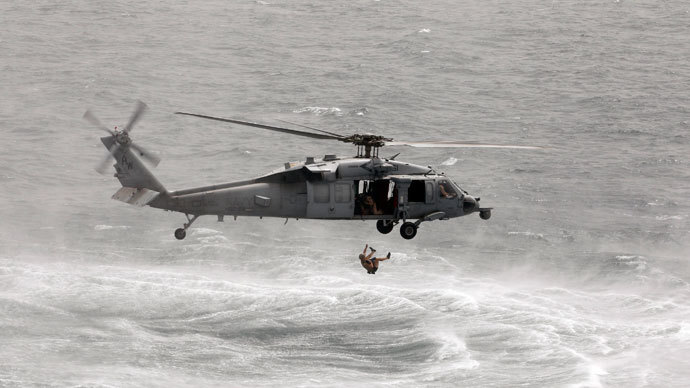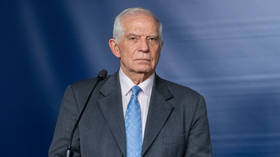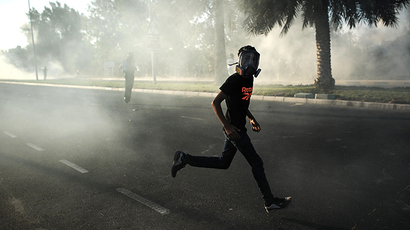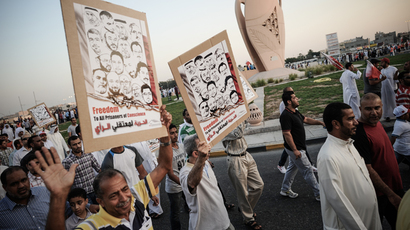'Bulwark against aggression'? US pushes MidEast militarization despite Iran thaw

Despite the historic Geneva Accord with Tehran, which calls for Iran to curb its nuclear activity in return for sanction easing, Washington is ready to boost military sales in the Gulf, as well as maintain its weighty presence.
US Defense Secretary Chuck Hagel told Gulf Arab leaders on Saturday the United States was committed to maintaining its vast military forces in the Middle East, as well as supplying its Arab clients with state-of-the-art military equipment.
"I am under no illusions, like all of you, about the daily threats facing this region, or the current anxieties that I know exist here in the Gulf," Hagel told the Manama Dialogue security forum in Bahrain on Saturday. "These anxieties have emerged as the United States pursues diplomatic openings on some of the region's most difficult problems and most complex issues, including Iran's nuclear program and the conflict in Syria."
Hagel confirmed that the US military “will not make any adjustments to its forces in the region — or to its military planning — as a result of the interim agreement with Iran."
The defense secretary’s comments come amid a general reduction of tensions in the region, not to mention the American people’s exasperation with foreign entanglements in an economic downturn. Although the US military is winding down its decades-long, super-expensive wars in Afghanistan and Iraq, US militarization in the region continues unabated.
The Pentagon is fielding more than 35,000 troops in the Persian Gulf, together with tanks, fighter jets and artillery that serve as a “bulwark against aggression,” Hagel said. Exactly where that source of “aggression” derives from, however, he failed to say.
Hagel is attempting to reassure the Arab world, not to mention Israel, that Washington has no intention of alienating the region, even as the United States has shifted its military attention, not to mention the bulk of its assets, to Asia.
Hagel, who told Congress last month that US isolationism is more of a threat than hubris, reminded his listeners of the 40 American warships and aircraft carrier fleet prowling the waters around the Persian Gulf and the Strait of Hormuz. Originally dispatched in late 2011 at the height of tensions with Iran, this massive US naval flotilla does not appear to be going home anytime soon.

In the last six months, US warships have traversed the Strait of Hormuz “a total of about 50 times,” he said.
The defense secretary also emphasized America’s “overwhelming” air power in the oil-rich region.
“We have deployed our most advanced fighter aircraft throughout the region, including F-22s, to ensure that we can quickly respond to contingencies,” he said. “Coupled with our unique munitions, no target is beyond our reach."
Hagel, himself a successful entrepreneur, then mixed a little business with diplomacy, saying the US encourages the six-nation Gulf Cooperation Council to purchase US defense systems.
"Going forward, the Department of Defense will place even more emphasis on building the capacity of our partners in order to complement our strong military presence in the region," he said.
"Our goal is for our allies and partners in this region to be stronger and more capable in dealing with common threats," he said.
Hagel’s figures, which only calculated US military assets without noting the prohibitive cost of these military activities, require the United States to aggressively sell its military weapons to Arab clients in the hope of breaking even. The irony of the situation is that the more weapons procured in the hands of Arab leaders, the higher the risk of some sort of confrontation breaking out.
Meanwhile, Hagel also mentioned the possibility of Arab countries working with the US on missile defense, a project that has been a primary source of contention between Moscow and Washington since the Bush years.
Moscow maintains the system, situated just miles from the Russian border, threatens to upset the strategic balance of power, thereby triggering another arms race.
This week, Russian Foreign Minister Sergey Lavrov, aware of an opening on the geopolitical chessboard, said the thaw in relations with Tehran meant there was no need for a European missile defense system, which Washington has argued is necessary for guarding against an Iranian missile strike.
Now, however, with Hagel discussing the sale of US missile defense systems in the Middle East, at the same time that the Iranian nuclear threat has been neutralized, Moscow, as well as many other countries in the region, has real reason for concern.














